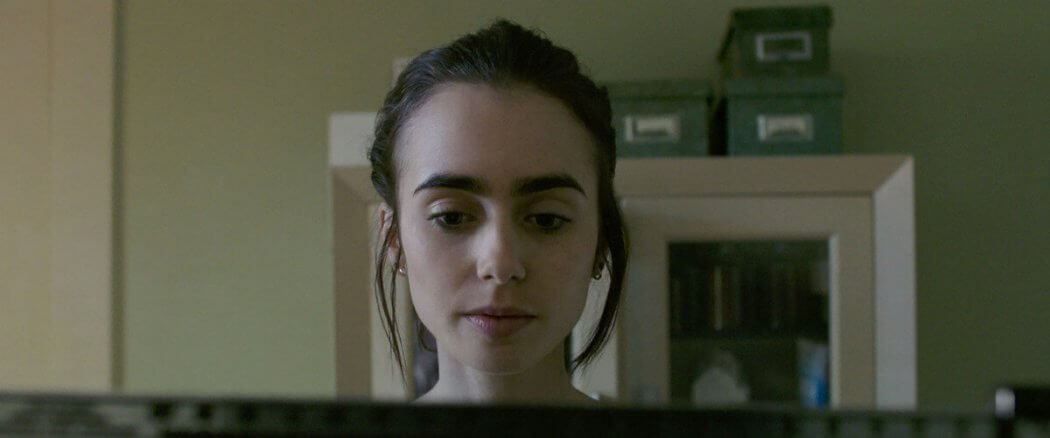Anorexia nervosa (AN) is one of a group of associated eating disorders which remain controversial in terms of cause and treatment. The general public sees these disorders as bizarre and puzzling. Many treatments have been attempted with limited success. Anorexia nervosa, and its associated illnesses, is a primarily psychiatric illness with a disturbingly high death rate (up to 4%*) mostly affecting teens or 20-something adults with a great predominance of females. Many theories have been postulated as to cause but, like many other conditions, the origin of eating disorders appears to be multifactorial (per the film, “Looking for one reason is a losing battle. It’s never that simple.”)
A Girl Lost
To the Bone tells the story of 20 year old Ellen (played by Lily Collins, daughter of Phil Collins and known for her roles in Okja and Amazon’s The Last Tycoon series in addition to a number of teen romances). In its opening scenes she responds to fellow patients in a group counseling session with bitterly funny but defensive put-downs (Sarcastic sigh… “Society’s to blame. The world is so unfair. I have to die.” Followed by her dismissive “There’s no point in blaming everyone. Live with it.” to a weeping group member). Of course the point of therapy was to learn to understand and control her AN, not to just “live with it.” She is eventually asked to leave the program. And this is not the first from which she has been dismissed.
 Ellen goes to the well-kept, upper class home of her father (who is never home, never seen), step-mother (who tries hard to love her prickly step-daughter) and her slightly younger half-sister (the most genuinely loving relationship Ellen has). Her step mother, Susan (the familiar Carrie Preston of True Blood and many other TV series) makes every effort but is no match for Ellen’s cutting wit and defiance. When Ellen is asked by her sister to give her the caloric count of each of the foods Susan has laid out to tempt her to eat, she rattles off each food’s exact calories until Kelly says, ruefully “It’s like you have calorie Asperger’s.” As for Susan, she is weary, as are so many families of the mentally ill, and she is not sure she has it in her to once again try to deal (pretty much on her own) with Ellen’s condition. Ellen’s biological mother Judy, played by Lili Taylor (so excellent in TV’s American Crime series), came out when Ellen was 13 years old and she now lives with her partner on a ranch in Arizona. Ellen lived with her until 18 months previous when Judy “couldn’t take it anymore” due to her own psychiatric (bipolar) issues. Ellen was shipped back to her father, who clearly does not want her problems in his lap.
Ellen goes to the well-kept, upper class home of her father (who is never home, never seen), step-mother (who tries hard to love her prickly step-daughter) and her slightly younger half-sister (the most genuinely loving relationship Ellen has). Her step mother, Susan (the familiar Carrie Preston of True Blood and many other TV series) makes every effort but is no match for Ellen’s cutting wit and defiance. When Ellen is asked by her sister to give her the caloric count of each of the foods Susan has laid out to tempt her to eat, she rattles off each food’s exact calories until Kelly says, ruefully “It’s like you have calorie Asperger’s.” As for Susan, she is weary, as are so many families of the mentally ill, and she is not sure she has it in her to once again try to deal (pretty much on her own) with Ellen’s condition. Ellen’s biological mother Judy, played by Lili Taylor (so excellent in TV’s American Crime series), came out when Ellen was 13 years old and she now lives with her partner on a ranch in Arizona. Ellen lived with her until 18 months previous when Judy “couldn’t take it anymore” due to her own psychiatric (bipolar) issues. Ellen was shipped back to her father, who clearly does not want her problems in his lap.
A New Psychiatric Approach
Desperate, Susan hears of a physician, Dr. William Beckham, who has an unconventional method of treating eating disorders which is gaining notoriety. When Ellen reluctantly sees Dr. Beckham (who in a bit of unlikely casting is played by Keanu Reeves) he initially seems to be gentle. Ellen tells him that she is only trying to be “healthy-thin”. He suddenly confronts her denial, “I talk to kids like you all day, every day. So I know that you are, as a rule, full of shit. You’re not just thin. You scare people. And I’m guessing you like that. But the way that you’re going, one day you won’t wake up. And I’m not going to treat you if you aren’t interested in living.”
He insists she be an inpatient in a group home for at least 6 weeks. The home has 5 other females and one male (who introduces himself as “Lucas… rhymes with mucous”). The rules are strict: no doors on rooms (except the bathroom); no electronic devices; attendance at all meals and therapy sessions is mandatory; no “cross-talking” over others; no talk of food or calories; no one leaves the table at mealtime and bathrooms are locked for 30 minutes after mealtime (to prevent regurgitation).
A Drama with Dark Humor — And Controversy
The dramedy has biting and irreverent humor throughout and made me laugh despite myself. But the serious lines drive to the heart and the director/screenwriter Marti Noxon (known for her script credits on many TV shows such as Glee, Buffy the Vampire Slayer, and Mad Men) knows of what she speaks, having a history of serious AN and having been treated by the inspiration for Dr. Beckham, Dr. Richard MacKenzie. In addition, and more controversially, Lily Collins also suffers in real life from AN. The fact that in preparation for the lead role Collins purposefully lost weight (allegedly under the watchful eye of physicians and nutritionists) has caused some groups to oppose viewing the film. They felt that the movie romanticized eating disorders and dwelt too “lovingly” on Ellen’s protruding ribs and spinous processes, encouraging anorexia patients to continue their pathology. But it was a big hit at Sundance and Netflix purchased the project without hesitation. The internet is full of attacks on the film as well as those who would defend it, with impressive credentials on both sides.
 But I think this movie is more than a sensationalistic, voyeuristic, or Lifetime “diagnosis-of-the-week” film. The wit and perceptiveness of Noxon’s screenplay is impressive. The characters of Ellen and her sister Kelly are compelling, as is Lucas (Tony Award winner for his stand-out Broadway performance in “The Curious Incident of the Dog in the Night-Time” but relative film newcomer, Alex Sharp). Ellen grows in her understanding and wisdom, as do we as we watch her struggles. There is no miracle cure or easy answer. Dr. Beckham at one point responds to Ellen when she asks what the point of life is “There is no point. Or, at least, big picture, we don’t get to know what it is.” At that moment I cry out for a faith-based perspective but, of course, you will not see that in most secular film productions. But regardless (SPOILER), Ellen overcomes her fear of abandonment and loss to become a more fully functional human being just as, apparently, Marti Noxon and Lily Collins have done.
But I think this movie is more than a sensationalistic, voyeuristic, or Lifetime “diagnosis-of-the-week” film. The wit and perceptiveness of Noxon’s screenplay is impressive. The characters of Ellen and her sister Kelly are compelling, as is Lucas (Tony Award winner for his stand-out Broadway performance in “The Curious Incident of the Dog in the Night-Time” but relative film newcomer, Alex Sharp). Ellen grows in her understanding and wisdom, as do we as we watch her struggles. There is no miracle cure or easy answer. Dr. Beckham at one point responds to Ellen when she asks what the point of life is “There is no point. Or, at least, big picture, we don’t get to know what it is.” At that moment I cry out for a faith-based perspective but, of course, you will not see that in most secular film productions. But regardless (SPOILER), Ellen overcomes her fear of abandonment and loss to become a more fully functional human being just as, apparently, Marti Noxon and Lily Collins have done.
Beautiful Scenes/Impressive Lines
The film displays, at times, beautiful cinematography. There is a visit of the group home residents to the “Rain Room” at the Los Angeles County Museum of Art that is breath-taking, even if it seems very incidental to the plot development. And there is a scene where Ellen and her half-sister Kelly sit on a hillside with the lights of the city diffusely arrayed before them. Kelly has just told Ellen to please really try when she goes into her next treatment and Ellen responds saying “I’ve got it under control. Nothing bad is going to happen.” — a statement I often heard from my patients suffering from mental illness. Kelly then looks off at the city’s lights and responds “How many people do you think are down there? Like, two million? I bet a bunch of them who are about to die just said the exact same thing.” That line, given in such an awesome setting, hits like a sledgehammer.
The climax of the film is also very imaginative and well-directed. A dream sequence (at first you are not sure) occurs where Ellen is sitting in a barren tree looking down on herself huddled motionless on the ground. Then multiple other “Ellens” appear on other branches of the tree speaking as to whether or not life is worth living. Other people in her life appear and disappear. It sounds corny but I found it quite affecting. Staring at her naked self, curled on the ground in fetal position, Ellen is confronted with the reality of her situation. Perhaps it is then she remembers Dr. Beckham telling her “I can’t reassure you. This idea you have, that there’s a way to be safe, it’s childish and cowardly. It stops you from experiencing anything, including anything good… Stop waiting for life to be easy. Stop hoping for someone to save you.”
Some Serious Flaws
I generally liked the film and it made me appreciate the pain of, especially, the families of AN patients. But it had some bothersome distractions. There is a subplot involving someone killing herself because of art work that Ellen published on the internet. This storyline seems unnecessary and pointless to me… does it imply that all AN patients have such a dark, horrible secret in their past? And worst of all is a late-in-the-movie scene where her biological mother Judy decides Ellen’s problems were caused because she, her mother, had post-partum depression and did not breast-feed Ellen. Grotesquely, the remedy was for her to hold Ellen in her lap and simulate breast-feeding by giving Ellen rice milk out of a baby bottle. Clearly Judy was doing this for her own needs rather than Ellen’s. At that point I almost turned the movie off.
 Another questionable moment in the film comes after a crisis in the group home, at which point Dr. Beckman gives a poem to one of the residents to read to the others. The poem is “Courage” by Anne Sexton and expresses beautiful sentiments including the line “Your courage was a small coal that you kept swallowing.” This line is central to a later, pivotal moment in the film but a viewer has to be very perceptive to not miss it and be left in confusion. In addition, the poem is somewhat problematic in that Anne Sexton committed suicide when 45 years old by carbon monoxide poisoning. Her last two collections of poetry, including “An Awful Rowing Towards God” in which “Courage” is published, are often macabre and dwell on themes of death. It is, I think, an odd poem to include in a film which is trying to say “Life is worth living, despite its pain.”
Another questionable moment in the film comes after a crisis in the group home, at which point Dr. Beckman gives a poem to one of the residents to read to the others. The poem is “Courage” by Anne Sexton and expresses beautiful sentiments including the line “Your courage was a small coal that you kept swallowing.” This line is central to a later, pivotal moment in the film but a viewer has to be very perceptive to not miss it and be left in confusion. In addition, the poem is somewhat problematic in that Anne Sexton committed suicide when 45 years old by carbon monoxide poisoning. Her last two collections of poetry, including “An Awful Rowing Towards God” in which “Courage” is published, are often macabre and dwell on themes of death. It is, I think, an odd poem to include in a film which is trying to say “Life is worth living, despite its pain.”
I give credit to Noxon that there was no joyously happy epiphany at the end of To the Bone, nor did the film promise Ellen would be cured. And several other residents in her group home left without, apparently, finding benefit from the non-medicinal, introspective treatments that Dr. Beckham, i.e. Dr. MacKenzie, championed. No, just as there is no one cause of eating disorders, it would appear that there is no one treatment to move everyone towards a cure. But watching To the Bone will make one aware and sympathetic towards the 10 million women and 1 million men who struggle with this illness sometime in their lifetime.** And the script makes one question how we raise children in our society. It is too easy to blame advertising media for some young people’s emphasis on image. One wonders whether the rise of eating disorders in the last century is due to our detached, individualistic lifestyle and/or a lack of a philosophical foundation that gives our lives meaning and our bodies to be seen by us as God’s temple.
__________________________________________
*Crowther et al., 1992; Fairburn et al., 1993; Gordon, 1990; Hoek, 1995; Shisslak et al., 1995
**Crow, S.J., Peterson, C.B., Swanson, S.A., Raymond, N.C., Specker, S., Eckert, E.D., Mitchell, J.E. (2009) Increased mortality in bulimia nervosa and other eating disorders. American Journal of Psychiatry 166, 1342-1346.



